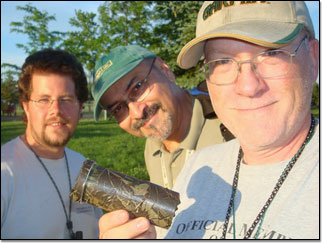
Why have visitors from all around the world been snooping around Michigan searching for hidden treasures?
Probably because there are over 1000 hidden treasures, or “caches,” hidden in various areas around the Detroit metropolitan area. These caches are part of the “geocaching” game, which is one of the fastest growing hobbies in America.
Geocaching is a great way to teach your children a variety of skills: research, organization, how to read maps and GPS systems, and how to enjoy the great outdoors.
“The basic idea of geocaching is to have people set up caches all over the world, and then share the locations of these caches on the internet,” according to information on the geocaching website, http://www.geocaching.com. The website states that geocaching is “the sport where you are the search engine.”

Those who hide the caches rate them 1-5 for difficulty and terrain. Once a
cache is hidden and then posted, others can go to the website and obtain the
coordinates as well as other clues as to where the cache is hidden.
Then the real fun begins. Driving, hiking and biking are involved, and many
people incorporate their geocache searches with day or week long outings to the
parks. When a cache is found, a notebook is signed and cachers exchange an item
from the cache for a new item of their own. When they return home, they log onto
the website and note details of their search and find. They can also elect to
receive updates from others who visit the cache.
Doug Vandenberg of Milford says that geocaching allows him to visit new parks
and areas he never knew existed. “It is excellent exercise,” he said, “and a mix
of science, computer, mapping, planning and hunting skills.”
David Brown of Davisburg agrees. “Geocaching is the perfect combination of high
tech and the outdoors,” he said. Since 2002, Brown has found about 550 geocaches
in four countries and at least 20 states. “I was geeked then and I still
thoroughly enjoy it,” he said. “It allows me to include my grandchildren in my
activities….and gives me an activity to enjoy while I travel.”
The only equipment necessary for this hobby is a Global Positioning System
(GPS), which detects the N/S and E/W coordinates of the cache location. GPS
handheld systems can be purchased for around $100 at Radio Shack and similar
stores. The basic unit is perfect for beginners, and should perform all the
functions necessary to participate in the hobby.
What items might be found in a cache?
First, each cache has a logbook so that visitors can leave their names and
the dates. This logbook may also contain other information such as clues to
finding other caches, jokes or historical information about the area. In
addition, caches usually contain items such as trinkets, maps, books, cards,
CD’s, videos, pictures, jewelry, tickets, tools or games. There are also
“virtual caches,” which can lead the treasure hunters to points of interest such
as historical monuments, scenery, or other existing signs or landscapes.
“As a kid, I was always taught that history was in faraway places,” said Ken
Browne of Brownston. Browne started geocaching three years ago when the sport
was new. Once he was introduced to geocaching, he realized that Michigan is full
of history too. “I remember the first geocache that I did, I couldn’t even sleep
the night before because I was so excited,” he said.
The game is made even more interesting and educational with “travel bugs,” which
can be purchased on the geocaching website for $5.99. A travel bug is a little
figure with an id tag which lists a number and destination. Cachers move travel
bugs from cache to cache to get them closer to their destinations. Those who
move a travel bug can also elect to receive updates when that travel bug is
moved or reaches its destination.
State parks and metro parks are very popular places to hide geocaches, which is
why there are so many in the Huron Valley area. Kensington was the choice for
Brighton’s Rick Wasalaski to hide his first cache. Wasalaski has been geocaching
with his wife Barb and son Matt since 2002.
“Geocaching is a great activity that can be enjoyed by the entire family,”
said Wasalaski. “It combines high-tech equipment and (sometimes) 'wild'
surroundings with one's desires of exploration and discovery.”
John Hendricks of Redford agrees. “We like the park and how the birds eat out of
your hands,” he said. “We camp around a lot and always find caches where we go.”
Today there are over 200,000 caches in over 200 countries. The game started in Oregon in 2000.
return to blitzkriegpublishing.com home page